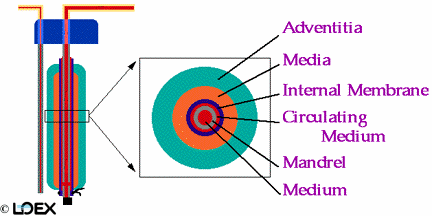See the web pages of François A. Auger and Lucie Germain

The scientific activities in vascular organogenesis are grouped under the LAEX (Laboratoire d’angiogénèse expérimentale - Laboratory of Experimental Angiogenesis), which was created in 1990.
The main goal of our research is to recreate in the lab the three distinct layers that form blood vessels. Each of these layers is made of a different cell type: the intima is composed of endothelial cells, the media of smooth muscle cells and the adventitia, or outer layer, of fibroblasts. It is, without a doubt, our most complex tissue-engineering model. The following figures illustrate our methodology of vascular reconstruction.
Vascular substitute reconstruction method (First model):

Vascular substitute reconstruction method (Second model):

Scientific goals:
The clinical goal of the Laboratory of Experimental Angiogenesis is to produce blood vessels with an internal diameter of 4 mm or less. There are at present no acceptable clinical solutions to be found among prosthetic vessels made from biomaterials in this range of diameters: all of these prostheses provoke rapid and irreversible thrombosis. We believe that adequate functional anti-thrombotic properties in our tissue-engineered model could avoid this problematic.
On the experimental side, vascular models are used in many ways: in vascular physiology to research not only contractility but also thrombosis and intercellular exchanges, and in pathology for examining aspects of atherosclerosis and diabetes, to name only a few. They are equally of interest in the pharmacology industry for the study of diverse compounds that act upon endothelial function or vascular motility
